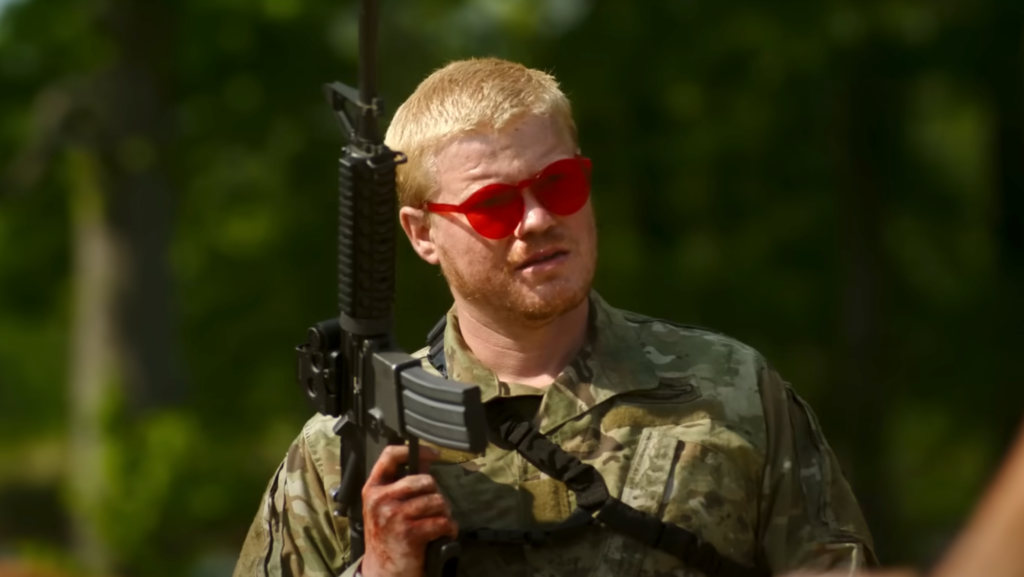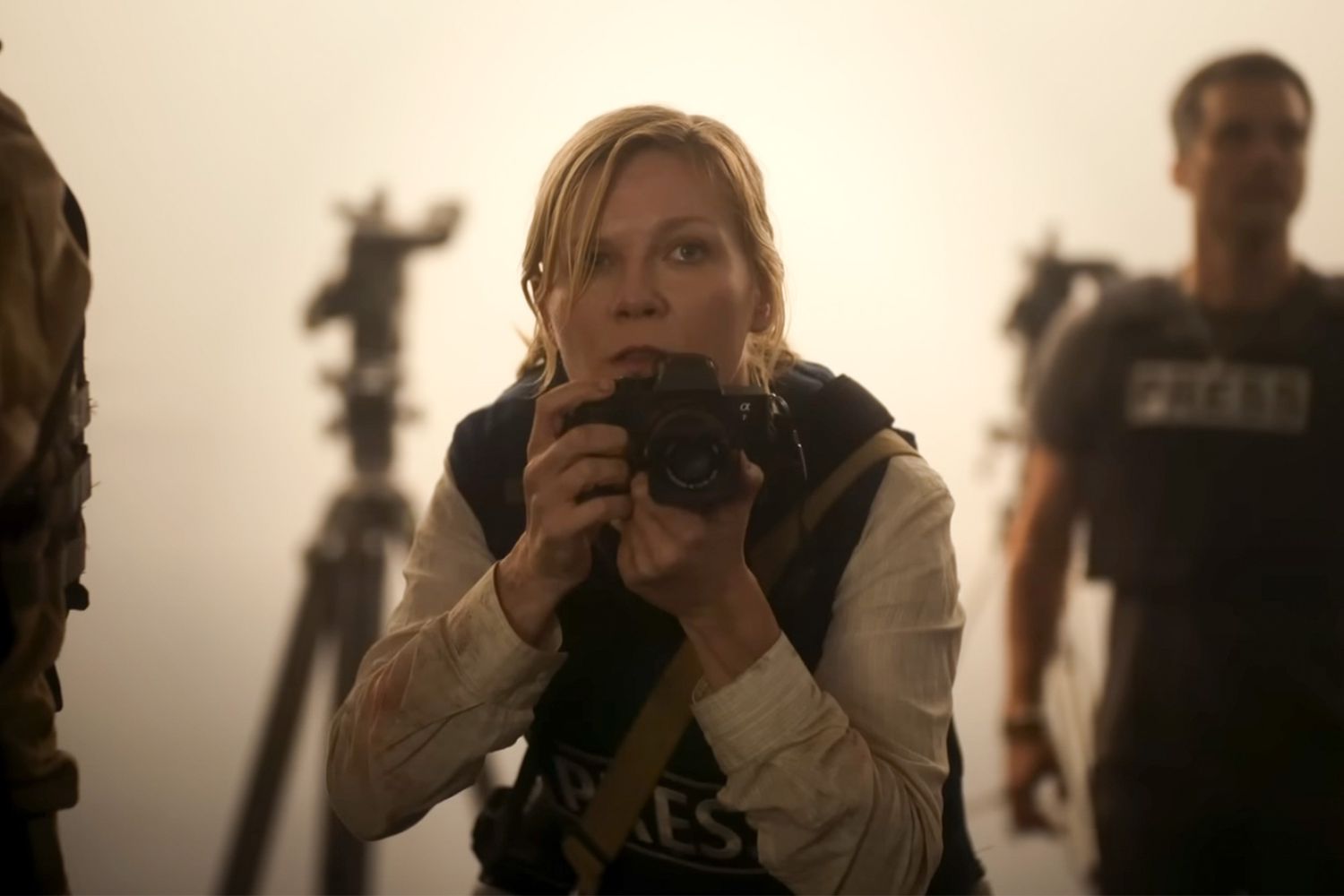Alex Garland’s button pushing Civil War offers a vision of the United States as hell, a near-future dystopian hallucination of a country torn by militias and warcraft, marked by third-term presidents, secession-driven military factions, guerrilla citizenry and wearily intrepid journalists documenting its descent. Telling his picture through the eyes of an under-fire press corps, it’s both a gripping and frustrating experience, a deliberate “what if?” provocation at once thrilling and vacuous, squandering a bigger opportunity with an agnostic lack of commitment.
Pictures about wartime correspondents are nothing new—think this year’s Oscar-winning doc 20 Days in Mariupol, A Private War, The Killing Fields, Salvador and scores of others—but Garland’s (Ex Machina, Annihilation, Men) novelty here is to position American journalists not abroad or in the Third World, but right here at home, an eerie conceit that gives the movie a cautionary context at a cultural moment when considerations of how rapidly democracy gives way to the fist of “it’ll never happen here” authoritarianism are eerily plausible.
Civil War opens with Nick Offerman as a third-term president, hinting at a regime that has disbanded the FBI and resorted to violence against journalists. The film sidesteps political polemic, focusing instead on a nation all but destroyed by a vaguely drawn conflict, with various militant factions emerging, including an antithetical “Western Alliance” alignment of secessionist states Texas and California, and a mysterious Florida faction, all of which have been in combat for, as suggested, about a year and half. Garland avoids explicit conflict exposition, instead plunging us into a war-torn landscape where for most survival outweighs ideological allegiance. Normal life has crumbled in cities like New York, with battles erupting in the streets, and small-town America’s Main Street is mostly empty, its businesses shuttered amidst armed clashes and sniper threats. Garland’s vision of such an erosion of normalcy and safety is both vivid and shocking.
In the middle of the melee is a haunted Kirsten Dunst as veteran photojournalist Lee Smith, a purported legend behind the lens and played by Dunst with a seen it all, been through it all jadedness. Her colleague, Joel (Wagner Moura), is the writer to her photos, and seasoned Sammy (an excellent Stephen McKinley Henderson), is a veteran NYT journalist who warns them against making a road trip from New York down the perilous eastern seaboard, fraught with bloody conflict, for a major opportunity to interview the president. At the same time, rebel soldiers, headquartered in Charlottesville, plan to topple the White House and execute the commander in chief. Who will get there first?

Enter Jessie (Cailee Spaeny), whom Lee shields from a Manhattan bombing, herself a fledgling photographer and Lee acolyte who hitches herself to the pair, a sort of protege on the very dangerous drive from New York to D.C. This trek includes a travelogue of tent communities, stuck-in-time small towns, snipers at every turn and a truly harrowing sequence involving an American purity test (“What kind of American are you?”) given by rural militiaman Jesse Plemons, whose evil in broad daylight performance provides the film’s best moment. The picture eventually winds its way to Pennsylvania Avenue for a tense showdown obliterating much of the capitol in a hail of urban warfare.
All of this is gripping, if not revelatory. The central problem with Civil War is that its context is what is most interesting, and beyond cursory exposition the film provides little rumination on its its upside down America, how exactly it happened and what its characters feel about it, content to offer a series of hyper violent terrors (it resembles the zombie apocalypse of Garland’s screenplay for Danny Boyle’s 28 Days Later) in a road movie with much road and less contemplation. Even its view of its journalists is stepped in what we already know, mostly formed by movie conventions—older, seasoned and jaded photographer reluctantly takes young newbie, ripe to be disabused of both idolatry and innocence, under her wing. As they forge through danger, we wonder why they never have a discussion across their many highway miles and overnight shelters. Who are they, really? What do they think about the collapse of America? Garland dispenses with such contemplations in favor of visceral horror, which frequently sustains.
The notion of traveling in an SUV with a group of intrepid journalists across a war zone is, as always, a good movie convention, and Garland exploits this premise for maximum impact, staging intensely cinematic set-ups that tease out suspense, which is enough to carry us even when it becomes clear that the film simply isn’t interested in the bigger picture. Throughout, Dunst is given near constant close-ups to suggest her weariness; we believe her resignation and sense of futility; Spaeny is wide-eyed and appealing, her character inexplicably shooting on 35mm film (really?) which she develops with her own body heat; and Moura is saddled with an underwritten character who does little but drive; only in the final moment does he attempt anything resembling journalism.
As often as I was gripped by Civil War I was equally flummoxed. Picture this: journalists tagging along with both sides of the conflict like hangers on, getting little intel for stories. Then there’s the big question mark hanging over the film: who’s calling the shots here on the various sides and guerrilla factions? What do they ultimately want, and who’s bankrolling and strategizing? Later, what’s with the president’s entourage making a grand exit from the White House right in the thick of battle, opting for limos over secret tunnels? It’s like they’re auditioning for an action movie, not running a country. And why is the president still relaxing in the Oval Office, waiting for his doom, with just one Secret Service agent for protection? Talk about commitment to the job. Given that the city has gone up in a siege of flames, wouldn’t it make more sense to have made a clean exit far earlier?
Little of this makes sense, really, and it should have. Given the film’s relatively brief running time (the credits roll at an hour and forty-one minutes), Garland would have been wise to recraft the film with greater political and cultural context and character, good as Dunst—with her penetrating, always somewhere else gaze into the abyss—is in every moment.
That’s not quite enough.
2 1/2 stars



